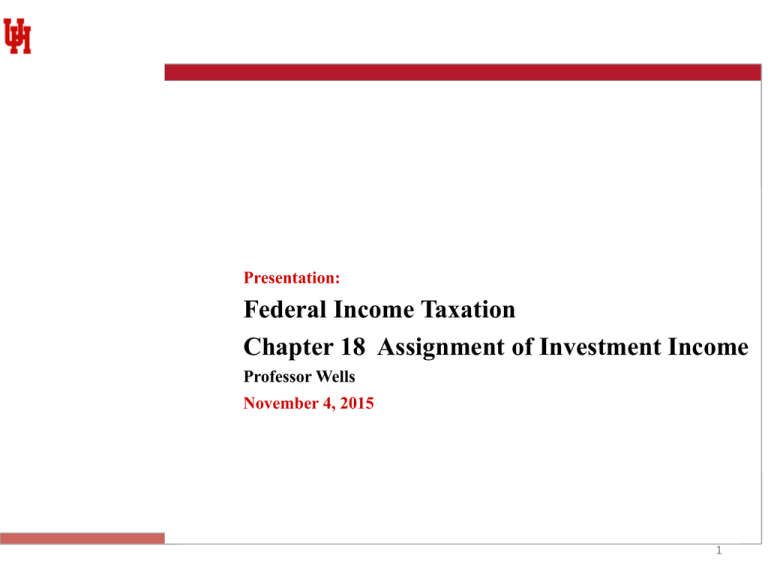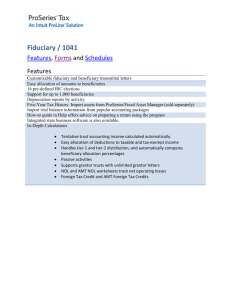Document 10895201
advertisement

Presentation: Federal Income Taxation Chapter 18 Assignment of Investment Income Professor Wells November 4, 2015 1 Chapter 18 Whose Income is It? P.1057 Fundamental inquiries in this chapter: Who is the taxpayer? whose income? whose deductions? How take advantage of “multiple runs up the bracket ladder”? How can income or deductions be attributed to another taxpayer? 2 Choices for Identifying the Taxpayer Unit Choices for possible income/deduction shifting: 1) spouses; 2) children; 3) other family members; 4) family entities (trusts, corporations & partnerships) Alternative: the entire family (how defined?) Cf., perspective of other cultures 3 Comparing Income Tax Rates Rate Brackets and Marginal Rates for individuals - Code §§1(a)-(d) & (h) Marginal rates - tax rate applicable to the last taxable dollar. Cf., effective rate (or average rate). Tax rates for corporations: Code §11. 4 Corliss v. Bowers Property Income p.1058 FACTS: Taxpayer transferred assets into a trust fund for children but retained the right “to modify or alter in any manner, or revoke in whole or in part, this indenture and the trusts then existing, and the estates and interests in property hereby created.” Holding: Grantor is taxable on the trust proceeds. [T]axation is not so much concerned with the refinements of title as it is with actual command over the property taxed—the actual benefit for which the tax is paid. If a man directed his bank to pay over income as received to a servant or friend, until further orders, no one would doubt that he could be taxed upon the amounts so paid. . . . . The same right existed here although it is not called a title but is called a power. 5 Douglas v. Willcuts Property Income p.1060 Taxpayer transferred funds to a trust for benefit of wife in lieu of alimony. IRS said that the trust income was taxable to the taxpayer and that the taxpayer made alimony payments to his ex-wife. Court held for IRS, stating: “We have held that income was received by a taxpayer when, pursuant to a contract, a debt or other obligation was discharged by another for his benefit. The transaction was regarded as being the same in substance as if the money had been paid to the taxpayer and he had transmitted it to his creditor.…The creation of a trust by the taxpayer as the channel for the application of the income to the discharge of his obligation leaves the nature of the transaction unaltered.” Subsequent Event: §682(a) changes this result for alimony trusts. 6 Burnet v. Wells Property Income p.1063 FACTS: Taxpayer established trust that paid insurance premiums on taxpayer’s life insurance. Held: Grantor remains subject to taxation on income of the trust. Trusts for the preservation of policies of insurance involve a continuing exercise by the settlor of a power to direct the application of the income along predetermined channels. . . . . He might have created a blanket trust for the payment of all the items of his own and family budget, classifying the proposed expenses by adequate description. If the transaction had taken such a form, one can hardly doubt the validity of a legislative declaration that income so applied should be deemed to be devoted to his use. Instead of shaping the transaction thus, he picked out of the total budget an item or class of items, the cost of continuing his contracts of insurance, and created a source of income to preserve them against lapse. 7 Blair v. Commissioner p. 1069 Edward Blair as the owner of a life interest under trust, but not the remainder interest (presumably for benefit of children). He transferred percentage interests in that life interest to his children. Assignments were valid under state law. Held: Assignment was valid and income attributed to the children and not to the assignor father. 8 Helvering v. Clifford Property Income p.1074 Grantor transferred funds into trust, the income of which would be for the benefit of his wife. Trust was to terminate in five years and the grantor was the remainderman. Grantor also was the trustee and had broad discretionary powers Held: Income of the trust was taxable to the grantor. “If it be said that such control is the type of dominion exercised by any trustee, the answer is simple. We have at best a temporary reallocation of income within an intimate family group. Since the income remains in the family and since the husband retains control over the investment, he has rather complete assurance that the trust will not effect any substantial change in his economic position. . . . [W] hen the benefits flowing to him indirectly through the wife are added to the legal rights he retained, the aggregate may be said to be a fair equivalent of what he previously had.” 9 Helvering v. Horst Property Income p.1080 Assignment of bond interest coupons to child shortly before interest due date. “The power to dispose of income is equivalent to the ownership of the income.” The anticipatory assignment of income is not permitted for income tax purposes. Cf., registered bonds & coupon bonds. 10 Helvering v. Eubank p.1085 Services Transformed into Property Facts: Eubank, an insurance agent, assigned renewal commissions (presumably as gifts). Held: The commissions are taxable to Eubank, when paid, not to the assignees. 11 Estate of Stranahan v. Commissioner (Supp. pp. 84-86) FACTS: Estate sold dividend strip to beneficiary for $150,000. Estate reported the transaction as immediate income to estate. IRS disagrees and claims this is an anticipatory assignment of income. Question: Why does the IRS contest the estate’s increased taxable income? Question: What is the benefit to the heir in doing this transaction? 12 Code §1286 Stripped Bonds p.577 Assign any tax basis from a bond to stripped interest coupons? Code §1286 provides that original basis in the instrument must be allocated between (i) the retained stripped bond and (ii) the stripped coupon. Allocation based on relative FMVs at the time of the stripping transaction. OID to accrue on each instrument (for both seller’s purchase and buyer’s retained interest). 1,000 100 100 100100 100 100 100 100100100 13 Income from (1) Property or (2) Services? Supp. pp. 87-88 Heim v. Fitzpatrick Assignment of patent license royalties to wife and children. Were royalties received by wife & children taxable to inventor/husband/parent? Held: gifts of income producing property – and not merely gifts of income. 14 Summary of Assignment of Income Personal Services Income þ Assignment of Present (Lucas v. Earl) or Deferred Compensation (Helvering v. Eubank) Patents/copyrights/art produced from personal effort (Heim) Gifts of Income Producing Property þ Donor retains underlying property and carves-out income (horizontal slice) or retains right to get the income producing property back. See Helvering v. Horst. But see §1286 for bonds Donor gives the underlying property (vertical slice). Taft v. Bowers. Income follows the property itself. Donor gives all that Donor has (even if donor only has a life interest or “horizontal slice”). Income follows the property itself. Blair v. Comm’r. Sale of Carved-Out Interest in Income Producing Property. Donor retains underlying property and sells a carved-out interest in income (horizontal slice). See Estate of Stranahan. 15 Final Thoughts: Income From Property Income from property is taxed to its owner. Gift of the property itself shifts the income from the property to the transferee. Gift only of income from the property (while retaining a remainder interest) will not shift the income to the recipient of that income. 16 Identifying “Carved-Out” Interests Examples: 1) Gift of dividends stream (for several years?) from corporate stock, but retaining the stock itself. 2) Gift of rent from a “rent house,” but not a gift of a remainder interest (or portion) in the house. Extend Code §1286 to these situations? 17 Income from Gift and Bequest Property §102(b)(1) - the income exclusion does not extend to the income received from the gifted property. Consider several trust interests: 1) the life tenant’s portion; and 2) the remainderman’s portion. Trust income is entirely taxed to the life tenant. E.g., gift of “income only” is not excluded from gross income; the entire benefit of the §102 exclusion is for the remainderman (when eventually receiving the remainder interest). 18 Trusts p.1089 (i.e., “Simple” or “Complex” Trusts”) Tax either to (1) trust or (2) beneficiary. §§651-652 – simple trusts – merely a conduit (p. 593). §§661-662 – complex trusts – taxation to the trust if income retained by the trust; or, tax to beneficiaries to receive income distributions. Very steep income tax brackets for trust income taxation. §1(e). 19 Trusts Grantor vs. Nongrantor Trusts p.1092 §671 provides for grantor trust (i.e., ownership) status, where: §673 – reversionary interest of grantor §674 – certain beneficial powers §675 – administrative powers §676 – revocation power §677 – subsequent distribution to grantor or spouse (or to satisfy support obligation) 20 Interest-Free Loans §7872 p.1098 1. A’s employer lends her $100,000 interest free to purchase a home. 2. B’s mother lends him $100,000 interest free to purchase a home. 3. What difference would it make in either of the above cases whether the loan were a demand loan or a fixed-term loan? What if the employer loan, in particular, were a 15-year term loan, but with a provision requiring payment sooner upon termination of employment? 4. Are there relationships other than those specified in §7872 in which an interest-free or belowmarket interest loan may represent a disguise for something else? 5 (a) Geraldine could simply make her parents a $40,000 interest-free loan to enable them to purchase the condominium and then increase her annual contributions from $6,000 to $21,700 to enable them to meet the resulting annual costs. 5 (b) Geraldine could seek to borrow $160,000 on her own credit and then lend her parents $200,000 with no interest to enable them to buy the condominium without a mortgage. (c) Geraldine might simply purchase the condominium herself and then let her parents live in it rent free. She would pay all the expenses of ownership, including mortgage interest and principal, directly. (d) Geraldine could purchase the condominium herself and then let her parents live in it charging them the existing ceiling rental of $6,000 ($500/month). In this case Geraldine would plan to treat her investment in the condominium as an income-producing investment. She would in this case also plan to give her parents about $6,000 a year in some other form to meet other expenses, so that their total budget would not be upset by the necessity of paying rent. 21 Partnerships Partnerships are conduit entities, not subject to federal income taxation. Each partner is allocated his share of each income and deduction item. Informational tax return to be filed, including K-1s (a W-2 or 1099 equivalent). Tax basis in the partnership interest enables loss flow through; tax basis includes debt (note the Tufts case) & allocated income. 22 Family Partnerships Can a parent make his children “partners” in a partnership and deflect income to them through the partnership arrangement? Cf., a service partnership vs. a capital investment partnership. §704(e) permits recognition of those partners who have a capital interest in the partnership where capital is a “material income-producing factor.” 23





